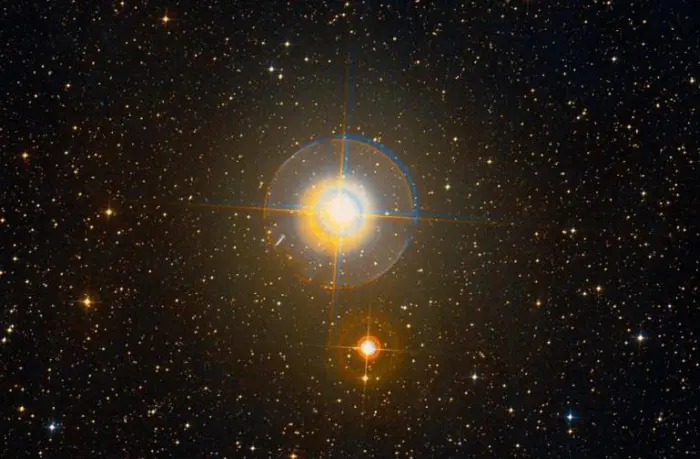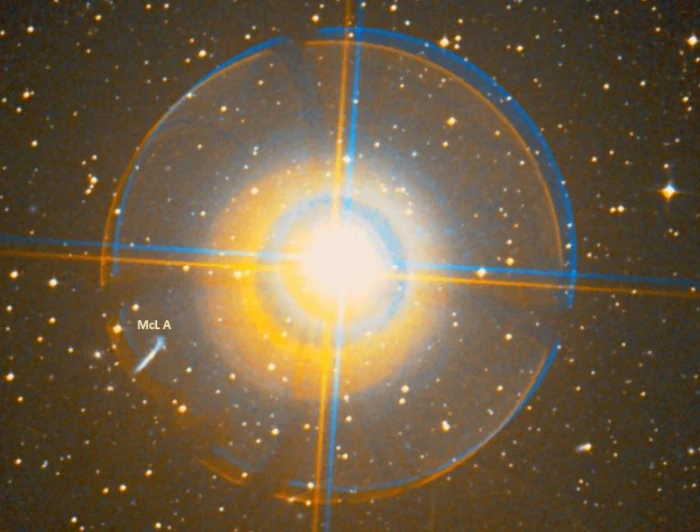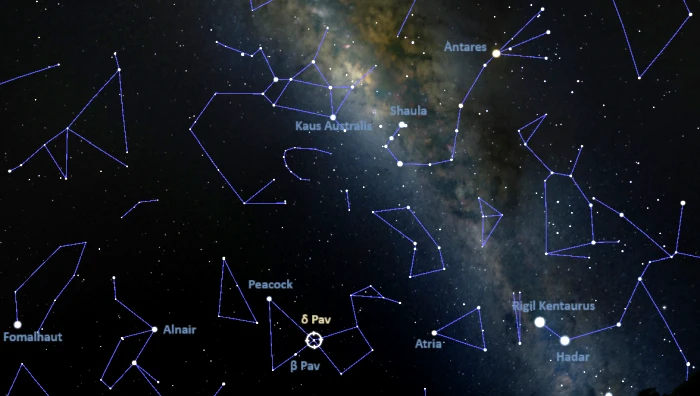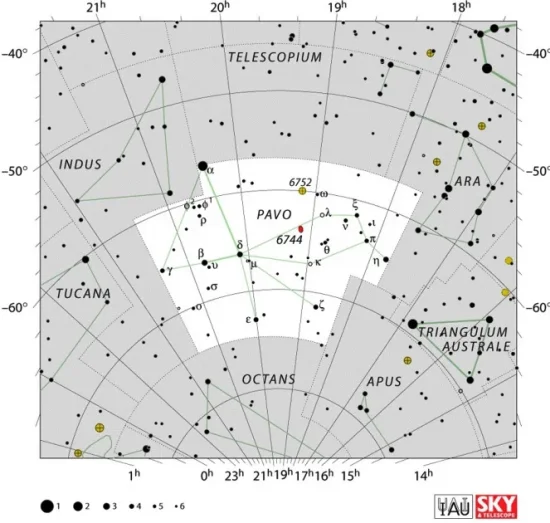Delta Pavonis (δ Pav) is a yellow subgiant star located 19.89 light-years away in the constellation Pavo (the Peacock). With an apparent magnitude of 3.56, it is the third brightest star in Pavo, after Peacock (Alpha Pavonis) and Beta Pavonis.
Delta Pavonis is one of the nearest visible stars to the Sun. It is the nearest solar analogue that is not part of a binary or multiple star system (with the possible exception of Tau Ceti). The star may host a Jupiter-mass planet, but the substellar companion has yet to be confirmed.
Star type
Delta Pavonis is a yellow subgiant of the spectral type G8 IV. It has a mass of 1.07 solar masses and a radius of 1.197 solar radii. With a surface temperature of 5,609 K, it shines with 1.24 solar luminosities. The star has a high metallicity (0.371), which makes it more likely than an average star to host planets. It has an iron abundance 235% that of the Sun and is considered super metal-rich. The high metal abundance has slowed down the star’s evolution.
Delta Pavonis appears to be a slow spinner. With a projected rotational velocity 0.32 km/s, it takes around 21.4 days to complete a rotation. It has an estimated age of around 6.10 billion years.
Delta Pavonis is a solar analogue. It is only slightly cooler, larger, more massive and more luminous than the Sun. Unlike the Sun, which is still fusing hydrogen into helium in its core, the older Delta Pavonis has run out of its supply of hydrogen and is in the process of evolving away from the main sequence. It will soon (astronomically speaking) become a red giant.

Delta Pavonis, image credit: ESO/Digitized Sky Survey 2 (CC BY 4.0)
Planet
Delta Pavonis is suspected to host a Jupiter-like exoplanet. A 2021 study used astrometric data and found a trend in the star’s radial velocity that indicates the presence of a gas giant. The proposed long-period planet orbits the star with a period of at least 37 years at an estimated distance of 11.1 astronomical units (Earth – Sun distances). It has a minimum mass of 69 Earth masses (0.22 Jupiter masses) and causes small changes in the star’s orbital motion, much like Jupiter causes a small displacement of the barycenter (center of mass) in the solar system. However, the existence of the planet has not been confirmed.
The candidate planet’s mass and orbital elements were derived based on data obtained with the High Accuracy Radial Velocity Planet Searcher (HARPS), HIgh REsolution Spectrometer (HIRES), University College London Échelle Spectrograph (UCLES), Automated Planet Finder (APF), and Planet Finder Spectrometer (PFS) instruments in 2023.
Facts
As one of the nearest Sun-like stars to Earth, Delta Pavonis has long been one of the most popular targets for SETI (search for extraterrestrial intelligence) studies. In 2003, the star was selected as the “Best SETI target” among the 100 nearest G-type stars.
Margaret C. Turnbull, University of Arizona, Steward Observatory, and Jill C. Tarter, SETI Institute, presented a list of high priority SETI targets selected from the Catalog of Nearby Habitable Stellar Systems (HabCat), the Tycho-2 catalog, the 100 nearest stars and 14 old open clusters. Delta Pavonis was chosen as SETI’s most attractive target among the nearest stars based on its high metal content, thin disk kinematics, quiet chromosphere (low magnetic activity), small projected rotational velocity, and evolutionary stage slightly above the main sequence.
With an apparent visual magnitude of 3.56, Delta Pavonis is visible to the unaided eye on a clear, dark night. However, it does not make the list of the 300 brightest stars in the sky.
Delta Pavonis is the 103rd nearest individual star to the Sun. It lies at a similar distance to Gliese 268 (QY Aurigae) in the constellation Auriga and 82 G. Eridani in Eridanus.
Delta Pavonis is approaching the solar system with a radial velocity of -21.543 km/s. It is expected to come within 17.8 light-years of the Sun in about 49,200 years.
Delta Pavonis appears close to McLeish’s Object (McL A, PGC 64180, LEDA 64180) in the sky. The elongated emission-line galaxy was discovered by David McLeish in 1946. It is an interacting system approximately 492.5 million light-years (151 megaparsecs) away. The galaxy is around 228,309 light years (70 kpc) across. It appears just southeast of Delta Pavonis.
In fiction, Delta Pavonis was memorably used in Frank Herbert’s Dune series. The fictional Delta Pavonis hosted seven planets, including the lush oceanic world Caladan, the ancestral home of the House of Atreides.
The star was also part of the extended Alien universe. It was located in the Cerberus Sector of the Outer Rim Territories and hosted the planet Delta Pavonis IV (Surier 430).

Delta Pavonis and McLeish’s Object, image credit: ESO/Digitized Sky Survey 2 (CC BY 4.0)
Name
Delta Pavonis does not have a proper name formally approved by the International Astronomical Union (IAU). It is commonly referred to by its Bayer designation, Delta Pavonis. The star is listed as Gliese 780 (GJ 780) in the Gliese Catalogue of Nearby Stars, HD 190248 in the Henry Draper Catalogue, HR 7665 in the Yale Bright Star Catalogue, and HIP 99240 in the Hipparcos Catalogue.
Location
Delta Pavonis lies in the southern constellation of Pavo. It appears roughly halfway between Alnair (Alpha Gruis) in the constellation Grus (the Crane) and Atria (Alpha Trianguli Australis) in Triangulum Australe (the Southern Triangle).
The vertex of the Southern Triangle marked by Atria points in the direction of Delta Pavonis. These stars appear in the region between the first magnitude Fomalhaut (Alpha Piscis Austrini) in Piscis Austrinus (the Southern Fish) and Hadar (Beta Centauri) in Centaurus.
At declination -66°, Delta Pavonis is best seen from the southern hemisphere. It never rises for observers north of the latitude 23° N and stays low above the horizon from the northern tropical latitudes.

Location of Delta Pavonis, image: Stellarium
Constellation
Delta Pavonis is located in the constellation Pavo. The celestial Peacock is the 44th largest constellation in the sky. It stretches across 378 square degrees of the sky south of the celestial equator.
Largely invisible from mid-northern latitudes, Pavo is one of the 11 southern constellations introduced by the Dutch-Flemish astronomer Petrus Plancius in the late 16th century. These constellations were first depicted in the star atlas Uranometria, published by German astronomer Johann Bayer in 1603 and are considered members of the Bayer family of constellations. The constellations were unknown to European observers before the Age of Discovery. They are mostly named after the animals encountered by Dutch navigators on their journeys to the southern hemisphere.
Several Bayer constellations – Pavo (the Peacock), Phoenix, Tucana (the Toucan) and Grus (the Crane) – are collectively known as the Southern Birds.
Pavo is not particularly conspicuous in the sky. Its brightest star, the massive blue main sequence star Peacock (Alpha Pavonis) is about as bright as Polaris in Ursa Minor. It shines at magnitude 1.94 from an approximate distance of 179 light-years. It takes its proper name from the name of the constellation.
Other relatively bright stars in Pavo include the A-type stars Beta Pavonis and Epsilon Pavonis, the orange bright giant Eta Pavonis, the orange giant Zeta Pavonis, the hot blue Gamma Cassiopeiae variable Lambda Pavonis, and the metal-poor F-type star Gamma Pavonis. Pavo is also home to the orange giant or subgiant HD 181433, which hosts a system of three orbiting exoplanets, discovered in 2008.

Pavo constellation map by IAU and Sky&Telescope magazine (Roger Sinnott & Rick Fienberg) (CC BY 3.0)
Deep sky objects in Pavo include the Great Peacock Globular (NGC 6752), the fourth brightest globular cluster in the sky, the large Condor Galaxy (NGC 6872), the spiral galaxies NGC 6744 and NGC 6810, the irregular galaxy IC 4662, and the dwarf spheroidal galaxy Bedin I.
The best time of the year to observe the stars and deep sky objects in Pavo is during the month of August, when the constellation appears higher above the horizon in the early evening. The entire constellation can be seen from locations south of the latitude 30° N.
The 10 brightest stars in Pavo are Peacock (Alpha Pav, mag. 1.94), Beta Pavonis (mag. 3.42), Delta Pavonis (mag. 3.56), Eta Pavonis (mag. 3.61), Epsilon Pavonis (mag. 3.97), Zeta Pavonis (mag. 4.01), Gamma Pavonis (mag. 4.22), Lambda Pavonis (mag. 4.22), Pi Pavonis (mag. 4.33), and Xi Pavonis (mag. 4.35).
Delta Pavonis
| Spectral class | G8 IV |
| Variable type | Suspected |
| U-B colour index | 0.45 |
| B-V colour index | 0.76 |
| Apparent magnitude | 3.56 |
| Absolute magnitude | 4.62 |
| Distance | 19.89 ± 0.01 light-years (6.099 ± 0.005 parsecs) |
| Parallax | 163.9544 ± 0.1222 mas |
| Radial velocity | -21.543 ± 0.0001 km/s |
| Proper motion | RA: +1,211.761 ± 0.72 mas/yr |
| Dec.: –1,130.237 ± 0.103 mas/yr | |
| Mass | 1.07 ± 0.01 M☉ |
| Luminosity | 1.24 ± 0.03 L☉ |
| Radius | 1.197 ± 0.016 R☉ |
| Temperature | 5,609 ± 8 K |
| Metallicity | 0.371 ± 0.008 dex |
| Age | 6.10 billion years (5.85 – 6.36 billion years) |
| Rotational velocity | 0.32 km/s |
| Rotation | 21.4 ± 9.3 days |
| Surface gravity | 4.29 ± 0.02 cgs |
| Constellation | Pavo |
| Right ascension | 20h 08m 43.6088716052s |
| Declination | −66° 10′ 55.442769229″ |
| Names and designations | Delta Pavonis, Delta Pav, δ Pavonis, δ Pav, HD 190248, HR 7665, HIP 99240, SAO 254733, FK5 754, GJ 780, CD−66 2367, CPC 21 4651, CPD-66 3474, GC 27886, GCRV 12460, SKY# 37891, CSV 8399, LPM 722, LTT 7946, NLTT 48721, PPM 364428, LFT 1520, LHS 485, NSV 12790, PLX 4754.00, Ci 20 1187, CNS5 4994, JP11 3170, PM 20038-6619, SPOCS 876, GEN# +1.00190248, N30 4444, 1E 2003.9-6620, TD1 25955, GALAH 140713003901146, uvby98 100190248, 2MASS J20084376-6610563, TIC 409891396, UBV 17142, UBV M 24445, WEB 17675, Zkh 300, TYC 9098-1918-1, Gaia DR2 6427464325637241728, Gaia DR3 6427464123776727168 |